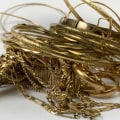It's easier and less expensive to own stocks or ETFs than physical silver, even though they are more liquid than those that really shine. Even so, owning bullion means that you have no counterparty risk (with a stock exchange or company, for example), although the investment depends solely on you for safekeeping. At first glance, buying an exchange-traded fund backed by ingots seems harmless. An ETF (or ETN, publicly traded promissory note) is a security that tracks an index, sector, commodity, or other asset, but that can be bought or sold like a stock.
For those looking for the best self directed IRA for gold, an ETF backed by gold bullion is a great option. The bottom line is that ETFs don't insulate you from the risks inherent to the financial system. They are not a substitute for directly owned physical gold and silver ingots. On the question of whether to own physical gold or not. ETF or physical silver stocks versus.
ETF stocks, we strongly recommend that you avoid ETFs. . The fund contains unencumbered and fully allocated silver ingots stored in vaults of the Royal Canadian Mint that are insured and audited. The spot price of silver cannot be used as an indicator for physical ingots because it does not include the cost of carrying.
Investors may not incur fees for storing their ingots in a securities drawer, but technically silver is stored in a space that is difficult to occupy. In addition, those investors basically insure themselves against theft and destruction, and this must be reflected in the return on investment. Currently, silver is experiencing several factors that catalyze its performance. The conflict between Russia and Ukraine is creating fear and uncertainty, making investors opt for safe assets such as gold and silver.
As a result, the price of oil is rising rapidly. This has an impact on the cost of producing silver and also increases the price. How long these catalysts will last cannot be predicted, but if peace is achieved, it will undoubtedly have a depreciating effect on the price of silver. But it's the closest thing to the real thing about a traded security.
Investors for tax purposes and is currently trading at a discount from the net asset value. For these reasons, I have invested a portion of my silver allowance in PSLV. As with most investment comparisons, there is no absolute and unique answer to this question. However, in the vast majority of cases, having physical metals will be the best long-term investment strategy.
Because of their lower levels of volatility, physical metal holds better hold their value during economic downturns. Futures and ETFs, unfortunately, can be subject to the short-term vagaries of the market, making their value uncertain. Investing in physical metals, as you might expect, involves buying and holding physical quantities of one or more precious metals. If any of these or other actions are carried out, physical gold will provide you with a form of money ready to meet any financial need or emergency.
Therefore, the main reason to buy a physical metal product instead of paper is because the nature of a crisis might demand it, at least for a short period of time. The advantages of physical metal investments stem mainly from the fact that they are predictable, consistent and have relatively low risk. There is a risk that the delivery will not take place, just as there is a risk that some of the gold or silver ingots owned by the fund will be taxed in some way. However, there are still some investment decisions to be made, the main one being whether to own gold and silver directly in physical form or indirectly through ingot substitute derivatives, such as exchange-traded funds (ETFs).
Investors who had storage receipts for gold and silver ingots in MF Global accounts had their assets frozen and joined those of other clients of the bankrupt company. And finally, to the extent that the shares of these ETFs sell short, some people with privileged information on silver, such as Ted Butler, have expressed concern that those short stocks cannot maintain their all-metal backing. The owners of a GLD, or iShares Silver (SLV) ETF, own shares in a trust that is supposed to be backed by metal. Some common examples of investments that may have a combination of collector value and bullion value are antique jewelry and rare gold or silver coins.
It's nearly impossible for retail investors to receive the ounces of gold or silver they think they own through ETFs. .



